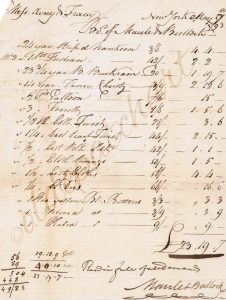
This is my first ever blog....eeeekkk and I have chosen to write about this interesting 1793 New York Bill of Goods that I found on eBay during 2003.
Straight away my eyes were drawn to the chintz.......I wanted an answer to that burning question: What did a yard of fancy chintz cost in 1793!?
Working out the relevant value today of something purchased 225 years ago comes with a whole lot of calculation that even the scholars really can’t agree on.
During the 18th century the monetary system in the colonies was in pounds shilling and pence.
There were 20 Shillings to the pound and 12 Pence per Shilling.
Also at the same time each colony had their own currency system. For instance the New York pound was worth 30% less than British sterling, with a NY shilling equivalent to only 8 pence sterling instead of the usual 12!
Confusing right?

First a Little Background :
Thomas Maule is the founding partner of the selling merchant: Maule & Bullock and was born in England around 1747.
At age 37 Thomas served as first mate for The East India Shipping Company on the inaugural voyage of a ship called the Winterton.
Thomas spent almost 4 years at sea where he sailed on two epic 20 month long voyages to Madras and Bengal upon the Winterton: (September 1782 – June 1784) and then again (February 1785 – October 1786).
Thankfully Thomas was already safely ensconced in New York by 1792 and not upon the ill-fated 4th voyage of the Winterton which had set sail for India before striking a reef off Madagascar and sinking!
Read more re this harrowing tale: http://www.jeanhood.co.uk/winterton.html
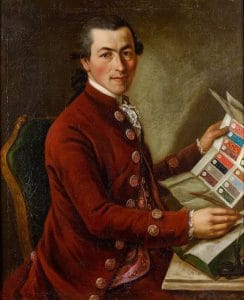
Thomas the Fabric Merchant:
Thomas first comes to our attention in 1786 as being on USA soil when he appears in the New York directories as ‘Maule – Merchant – 40 Hanover Street’.
He may well have jumped ship when he reached the colonies as Thomas Maule doesn’t appear on any passenger lists of that time and later fronts court to be naturalized as an alien. My theory is that Thomas may have started trading with goods shipped on his last voyage.
I found the following reference:
“Voyages to the East were lengthy & uncertain, but the rewards were good as captain and officers were allowed, in addition to their wages, to ship goods on their own account as private trade”.
By 1789 Thomas had taken on Richard Bullock as a partner with the business now listed as ‘Maule & Bullock, Merchants, 7 Hanover Street’, which later moved premises to 135 Pearl Street.
Thomas was granted a pension from the East India Shipping Company in 1804 for the sum of 60 GBP per annum with his condition listed simply as ‘infirmity’. It was a mere four years later, on January 2nd 1808 when our good friend Thomas dies intestate! One clue I found re his dire financial circumstances was a substantial debt owed to Maule & Bullock showing up in chancery court in 1797. The goods from five ships had been seized by the British crown - Maule & Bullock received neither their goods nor compensation!
Sadly Thomas hadn’t any family and it was two friends that made claim to Thomas’ meagre chattels.
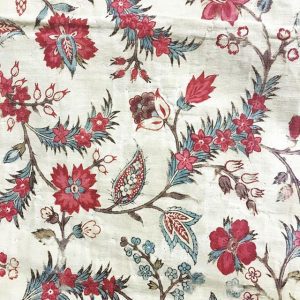
So back to our bill and the juicy bit we all want the answer to…..what DID a yard of chintz cost in 1793!?
Among the list of goods purchased on the 7th of May 1793 is our magical 14 x yards of ‘Fancy Chintz’ at a grand cost of 3 shillings 9 pence per yard with the total cost being two pounds, twelve shillings & 6 pence.
Wouldn’t we all just love a chance to stroke that chintz!?
Please note: These prices are very likely listed at wholesale cost as the buyers themselves were also merchants.
The buyers, Major Thomas Tracey and Samuel Avery, had formed a mercantile partnership ‘Avery & Tracey’ earlier that same year when the former married Avery’s daughter.
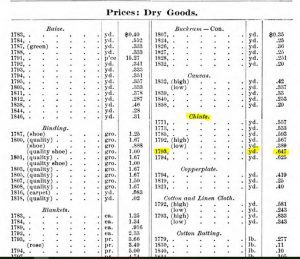
Converting that cost in 1793 currency to a current value in 2018:
To work out the equivalent value today, I asked Google and various calculators gave me all different answers ranging from £20.96 all the way up to £1842.00….so yeah not very helpful!
Using the purchasing power calculator on http://www.measuringworth.com we end up with the answer of £20.96 per yard wholesale.
For those of us playing at home in Australia, that = $38.51 AUD and the USA = $27.43.
I compared this figure with the retail cost per yard of chintz in 1793 as per online reference: “Comparative Wages, Prices & Cost of Living” by Carroll D. Wright.
This seems to be in the same ball park as our bill being listed @ $0.647 USD per yard.
https://babel.hathitrust.org/cgi/pt?id=wu.89071501472;view=1up;seq=112
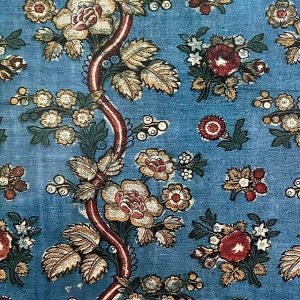
Okay so how did a yard of chintz relate to the cost of living in 1793?
I then decided to work out the comparison using wages of each era to try and get closer to our answer.
It seems that one yard of chintz was equivalent to approximately three quarters of a day’s wage.
In 1793 the average wage for a labourer in New York was 80 cents per day…..(or 10 fowls if you preferred your payment to be in chickens!!!)
Using the average modern US daily wage as of 2018 that’s around $96.00 USD per yard.
So we can already see a huge disparity between the calculators.
For all intents and purposes this is only a best guess answer........I am going to leave it to those more learned than I to see if we can conclude this conversion.
At the very least we can say the cost of a yard of chintz in 1793 was darned expensive!
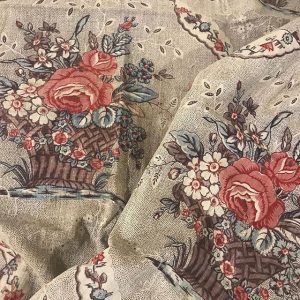
Some of the other fabrics listed:
Striped Nankeen: A sturdy, naturally coloured pale yellow or buff cotton twill cloth originating from Nanjing China, this was later emulated by dyeing the cloth in iron salts.
Interestingly this is costed out at a similar price per yard as the chintz!
Fustian: Originally a worsted (wool) fabric; fustian is a coarse textured cotton-linen weave usually produced for the lower end of market. The process was later refined to the point whereby manufacturers were able to develop a very fine fustian that passed for cotton.
Buckram: An unbleached cotton or linen cloth stiffened with either gum or paste that was used as an interfacing to stiffen clothing.
Galloon: A narrow ornamental strip of fabric typically a silk braid, tape, ribbon or lace used to trim clothing, uniforms, draperies and upholstery.
Ferrett/Finnith/Fessith?: This is one is a mystery to me & Google was no help at all, so at best guess - 'Ferrett' in which case it would be narrow goods like a tape, ribbon or binding. I would love to know what you all think this would be.
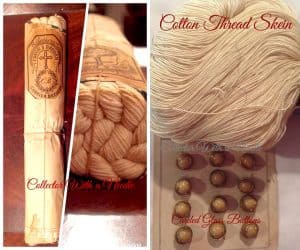
Next on the list we see cotton and silk threads purchased by the pound:
Dawn Ronningen kindly tells me that in the 18th century linen and silk threads were purchased by the hank or skein, much like embroidery floss is today.
These skeins would later be wound onto reels or thread winders at home.
Here’s a photo example showing 12 x skeins wrapped in paper and tied closed……measuring about 6” long x 1.5 inches at the open end.
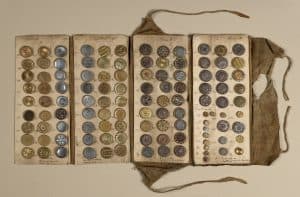
Button & Dies:
Following on from the thread listings we see 'Cloth Swings' and 'Best Cloths' which were also purchased by the pound?
1/4 pound of 'St. Dies'.....perhaps steel button dies?
Then an assortment of Bt buttons in yellow, silver and plated with a unit measurement of 1 x Gro .
1 Gro = one gross which is the equivalent of a dozen times a dozen or 144 items.
Perhaps we have some button enthusiasts that can solve what “Bt buttons” may be......boot or breast buttons perhaps?
Credit for this photo: Cooper Hewitt Museum: https://collection.cooperhewitt.org/objects/18710247/

Payment in Both Gold & Paper:
It’s interesting to note at the bottom of their bill, that Messrs Avery & Tracey settled their account using both ‘gold and paper’ with the total cost of their goodies being £23.19.7 - 'paid in full'.
In my opinion the cost would have been worth every last cent to buy those wonderful yards of chintz!
Whatever the conversion, I can’t see my other half being too thrilled with that kind of fabric bill!
-
In Conclusion:
As we know there are always sooooo many more questions than there are answers when it comes to researching historical documents or textiles……and this bill is no exception.
I ended up down a lot of rabbit holes and I can’t even imagine this kind of research before the internet: so my hat goes off to you all!
If you have any further information or ideas I would love you to share your thoughts, I believe pieces such as this represent an historical document relevant to ALL of us, rather than just me keeping it squirreled away in a box to myself. - At the end of the day the question we would all really love to know the answer to is:
‘What did a yard of fancy chintz cost in 1793?!’
-
Credits:
Images of the gorgeous fabric examples shown here belong to Christopher Moore – ‘The Toile Man’ who very kindly gave his permission to let me use any photos taken from his superb archive of early documents.
http://www.thetoileman.com/The photos of thread were very kindly supplied by Dawn Ronningen – ‘Collector With a Needle’…..Dawn was also very generous with her time and helped guide me with any questions I had on content.
http://collectorwithaneedle.blogspot.com/
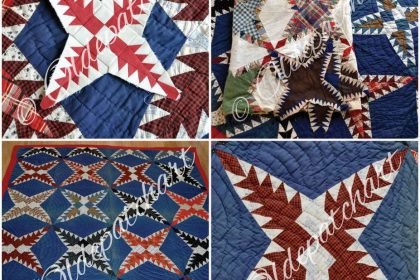
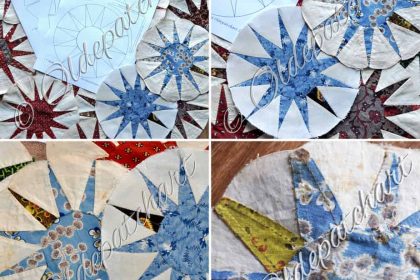
What a wonderful blog.
I worked in retail with pounds ,shillings and pence a long time ago
so it all looked familiar.
Dorothy
Thanks Dorothy, I’m glad you found it interesting. Pounds, shilling & pence was French to me until I looked into it further lol.
Great stuff – so much info & very very interesting – please keep blogging!
Thanks so much R….glad you enjoyed reading it.
VERY Much enjoyed reading your first post! Hope there are Many More to come!
Thanks so much Cyndi……glad you enjoyed it & I do have many topics up my sleeve.
This is soooo interesting, thank you for setting up this blog, looking forward to future blogposts.
I tried adding your blog to my Bloglovin list, but it would not work, maybe – since this blog is new – you did not make it available yet thru Bloglovin ? If not, it is quite easy to do, just go to their website and then it is just a few clicks, lots of people use it.
Thank you again for taking the time to share this with us.
Thanks so much Phyllis for your comment….glad you enjoyed it. I also really appreciate your ‘how to’ for adding it to bloglovin……newbie here so will see how I go. Thanks again for your suggestion.
Fabulous post! Keep them coming!
Thanks so much Wendy!
First paragraph in background: think you meant he was born about 1747. Thanks for posting. Very interesting.
Thank you sooooo much Rachel…..now fixed.
Wonderful! I look forward to reading more from you!
Thanks so much Trish.
I loved your blog! Very interesting & inspiring. I hope you have many more blogs to come. Thank you for sharing your research!
Thanks sooooo much Cindy…..glad you enjoyed it. I have plenty of posts to write – I just need the time to implement that lol!
According to this reference, the word is \”Ferret\” (Ferrett) and it is \”a strong tape of cotton or silk.\” (http://woodsrunnersdiary.blogspot.com/2011/06/18th-century-cloth-fabric-terminology.html)
Also, as a pure coincidence, a c.1800 Massachusetts whole-cloth quilt that I own includes 13.96 yards (appx. 14 yards) of printed chintz fabric – so perhaps the 14 yards identified above was meant for a quilt as well!?!?!
Thank you James……interesting theory re the 14 yards = a whole cloth quilt.
I do know that the purchasers were also merchants – Avery & Tracy……a partnership formed in 1793 when Major Thomas Tracy married Samuel Tracy’s daughter Elizabeth.
History is fascinating especially when it pertains to our passion. Thank you for your comment.